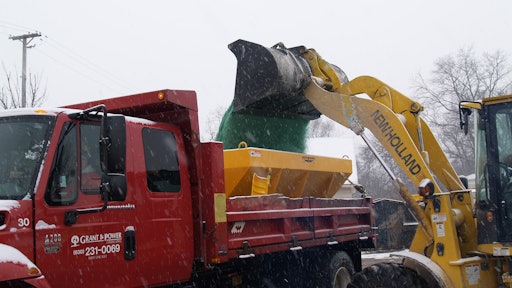
Although last season was a bit tamer in many parts of the Snowbelt, the previous few had tested the limits of salt supplies across North America. Contractors have consequently begun asking themselves, "How much salt do I need to procure, when and from whom, and at what cost to my business?"
Snow and ice management expert Jim Hornung Jr., CSP (certified snow professional), of Elbers Landscape Service in Buffalo, NY, spoke at the SIMA Symposium in Providence, RI, in June. He outlined some real-life tools and tips to help manage salt and deicing material inventory more effectively.
Turning cash into salt, and vice versa
Hornung says his family's landscape/snow company is fortunate to be based fairly close to its primary salt supplier. Generally speaking, they can receive a rock salt shipment within 24 hours of ordering it. Elbers Landscape Service is also fortunate to have enough room to store a large stockpile on-site. This gives them some flexibility as to how much salt they order at a time, and how often.
Nonetheless, the company still faces the same challenges all snow removal contractors face when it comes to deicing material. "Is rock salt an asset or liability?" Hornung asks. "It's a physical product, so it is inventory. You might know that you'll eventually use it, but if you over-purchase you could end up sitting on it for a year or longer. That's a lot of money piled on the pavement. It definitely becomes a liability if it isn't paid for. And even if you purchased it outright, that ties up a lot of cash for sometimes several months before you start using it and charging customers."
This is why Hornung says purchasing must be closely tied to billing. For example, you order your salt in early October and pay in 30 days (early November). You anticipate making your first application in early December and the client pays at the end of December. That's a roughly four- to seven-week gap between cash going out and cash coming in. Elbers likes to turn billing every 15 days, tightening that gap by a couple of weeks.
Easier said than done—but it can be done. It takes a commitment on your part, good communication with the client, and a clear process for billing and collections for your office team to follow. It's an important commitment to make because Hornung is not a fan of using a bank line of credit to purchase salt. "The bank looks at salt this way," Hornung explains. "The bank likes things they can easily liquidate and sell. Rock salt can be a challenge as you grow because banks don't really know what to make of it."
Bank credit aside, Hornung has found it to be advantageous to use his American Express card for salt purchases. "I don't use it as a credit card, I use it as a charge card," Hornung points out. "You have to understand the billing cycle and terms so you can stretch it out as far as possible but still pay it off. It can work if you are disciplined about it. I'd racked up enough points to pay for my trip to SIMA."
Forecasting needs
Will it be a light winter, a normal winter, or a real doozy? Weather prediction centers can make just that, predictions, but you never really know. Nonetheless, you have to forecast your salt needs somehow. Hornung says to start by analyzing your accounts and historical data.
Go client by client because clients typically have different service needs. Look at how much area (acres or square feet) you have to treat. How much material does it take to treat that area for that particular client? Do this exercise for each client. Then add it all up and multiply by the number of typical snow events.
Hornung cautions to not be so quick to follow standard industry benchmarks. "You are only concerned about your geographic area and your accounts," he explains. "Geography really matters because the type of snow event you get dictates how you treat it, i.e. wet lake effect snow compared to a normal snow."
It's also important to standardize your reordering point. Again, Elbers Landscape Service is lucky in that it can normally get a shipment in 24 hours. "But you must keep in mind weekends, holidays, and the weather events themselves which can slow things down," Hornung points out.
You should also identify a secondary vendor for both rock salt and bagged material, even if the pricing differs. "You need that backup plan," Hornung reminds. "And what if you pick up a new client in the middle of the season? This is where a secondary vendor can really come in handy."





























